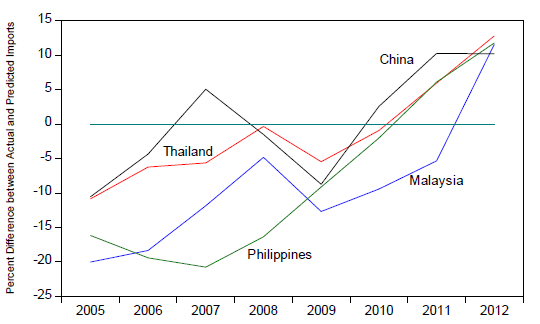| Author Name | THORBECKE, Willem (Senior Fellow, RIETI) |
|---|---|
| Research Project | East Asian Production Networks, Trade, Exchange Rates, and Global Imbalances |
| Download / Links |
This Non Technical Summary does not constitute part of the above-captioned Discussion Paper but has been prepared for the purpose of providing a bold outline of the paper, based on findings from the analysis for the paper and focusing primarily on their implications for policy. For details of the analysis, read the captioned Discussion Paper. Views expressed in this Non Technical Summary are solely those of the individual author(s), and do not necessarily represent the views of the Research Institute of Economy, Trade and Industry (RIETI).
International Macroeconomics (FY2011-FY2015)
East Asian Production Networks, Trade, Exchange Rates, and Global Imbalances
There has been an explosion of parts and components traded within East Asian production networks. China has emerged as the final assembly point for the goods produced. These goods then flow primarily outside of the region. When the Global Financial Crisis (GFC) occurred, the decrease in Western demand led to a synchronized decline in Asian exports. If more final goods could flow to Asian consumers, this would provide insurance against another slowdown in the rest of the world.
This paper uses a gravity model to investigate if emerging Asia is importing fewer consumption goods than predicted. As Figures 1a and 1b show, the results indicate that after the GFC, both China and the Association of Southeast Asian Nations (ASEAN) have imported more final goods than expected. The figures present the percent difference between actual and predicted imports for China and the three emerging ASEAN countries that are most involved in regional production networks (Malaysia, the Philippines, and Thailand). Figure 1a presents the results for consumption imports excluding cars, and Figure 1b presents them for consumption imports including cars. Both figures indicate that actual consumption imports have risen relative to predicted consumption imports between 2005 and 2012. For the ASEAN countries, in 2012, consumption imports excluding cars were 12%-13% greater than predicted and consumption imports including cars were 12%-15% greater. For China, in 2012, consumption imports excluding cars were 10% greater than predicted and consumption imports including cars were 20% greater. For all four countries, actual imports have been growing relative to predicted imports since the GFC.
Nevertheless, the ratio of consumption imports per capita relative to gross domestic product (GDP) per capita for China remains much lower than the corresponding ratio for other countries. This highlights the need to address structural issues that lead to the under-importing of final goods. One factor is tariffs on consumption imports into China and other protectionist obstacles. At the 2014 Asia Pacific Economic Co-operation (APEC) Summit, Chinese President Xi Jinping proposed a Free Trade Agreement for the Asia Pacific (FTAAP). By lowering the level of import protection, it would enable Chinese consumers to purchase more from abroad.
A second structural factor that hinders consumption imports is regulatory distortions that favor investment at the expense of consumption. For instance, China caps the interest rates that households can earn on deposits. These and other banking sector regulations have resulted in an artificially low cost of capital to large firms, stimulating investment. At the same time, the interest rate caps suppress household income and spending. As another example, large parts of the service sector are shielded from competition. Allowing open markets to play a larger role would help increase labor-intensive employment and thus raise incomes and consumption for many workers. The Chinese government, in the 2013 Third Plenum blueprint, vowed to change the incentive structure that favors firms and production at the expense of workers and consumption. These reforms would not only benefit Chinese consumers by allowing them to purchase more, but also would help China to continue developing as an engine of growth. This would make Asian economies more resilient to demand shocks emanating from the rest of the world.
Figure 1a. Percent Difference between Actual Consumption Imports
(excluding cars) and the Values Predicted by a Gravity Model

Note: Consumption goods come from the following categories: beverages, cars, carpets, cereal products, cinematographic equipment, clocks, clothing, consumer electronics, domestic electrical appliances, knitwear, miscellaneous manufactured articles, pharmaceuticals, photographic equipment, preserved fruit and vegetable products, preserved meat and fish products, soaps and perfumes (including chemical preparations), sports equipment, toiletries, toys, and watches.
Figure 1b. Percent Difference between Actual Consumption Imports
and the Values Predicted by a Gravity Model

Note: Consumption goods come from the following categories: beverages, cars, carpets, cereal products, cinematographic equipment, clocks, clothing, consumer electronics, domestic electrical appliances, knitwear, miscellaneous manufactured articles, pharmaceuticals, photographic equipment, preserved fruit and vegetable products, preserved meat and fish products, soaps and perfumes (including chemical preparations), sports equipment, toiletries, toys, and watches.
Source: CEPII-CHELEM Database and calculations by the author.

